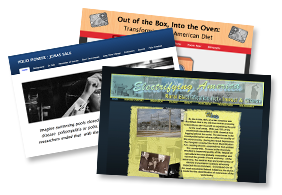Community Embraces New Word Game at Mid-Year Play Day This past Sunday, families at Takoma Park’s Seventh Annual Mid-Year Play Day had the opportunity to experience OtherWordly for the first time. Our educational language game drew curious children and parents to our table throughout the afternoon. Words in Space Several children gathered around our iPads […]
Read moreTag: museum

Real life has a close competitor in the “Art Project,” released by Google last week. Their initial release is a clean, inviting site for browsing over one thousand artworks from 17 of the world’s most famous museums. At least one piece from each of the 17 museums is displayed in gigapixel resolution, so that online visitors can zoom in to the brushstrokes. Each piece also has information about the artists, text or video commentary, bios, and links to related pieces. Some museums have 3D walk-throughs, analogous to Google’s map street views (there are 6000 3D panoramas), and there’s a way to create personal art “collections” to revisit or share later.
 In April 2009, a dozen 53-foot tractor trailers delivered the latest blockbuster exhibit — Harry Potter: The exhibition — to the Museum of Science and Industry in Chicago. The exhibit was big on magic, with 400 costumes and props from the films, including 17 wands, Harry’s famous round glasses, the Marauder’s Map, Harry’s Nimbus 2000 broom, Hermione Granger’s Yule Ball gown, and a lot of oversized furniture. The movie props were big draw. The exhibit was at the start of its tour, and the Chicago museum was the first venue. (more…)
In April 2009, a dozen 53-foot tractor trailers delivered the latest blockbuster exhibit — Harry Potter: The exhibition — to the Museum of Science and Industry in Chicago. The exhibit was big on magic, with 400 costumes and props from the films, including 17 wands, Harry’s famous round glasses, the Marauder’s Map, Harry’s Nimbus 2000 broom, Hermione Granger’s Yule Ball gown, and a lot of oversized furniture. The movie props were big draw. The exhibit was at the start of its tour, and the Chicago museum was the first venue. (more…)
Like museums in the physical world, WebExhibits presents information that is, for the most part, timeless. Yet WebExhibits also demonstrates a radical departure from physical museums, in terms of 24/7 accessibility, adaptation to support multiple learning styles, and cost-effectiveness. As of October 2010, 75% of U.S. households have high-speed Internet access, and virtually all students have Internet access at schools or libraries.
Virtual exhibits are cost effective. It costs only a few pennies to serve a WebExhibits visitor, in contrast with a typical U.S. museum’s cost of $23 per visitor.
IDEA presented and demonstrated “Concept Maps for Online Exhibits” at the 2010 Museums and the Web Conference, April 13-17 in Denver. Concept maps are a useful component of online exhibits, as they help meet the needs of multiple learning styles and provide an innovative way to visualize information. SpicyNodes’ radial mapping engine improves upon previous


 This weekend, I was a judge at a local chapter of
This weekend, I was a judge at a local chapter of  Museums increasingly realize that if they want government funding and support, they need to make a case for it, and get their voice heard. So today and tomorrow is ‘
Museums increasingly realize that if they want government funding and support, they need to make a case for it, and get their voice heard. So today and tomorrow is ‘